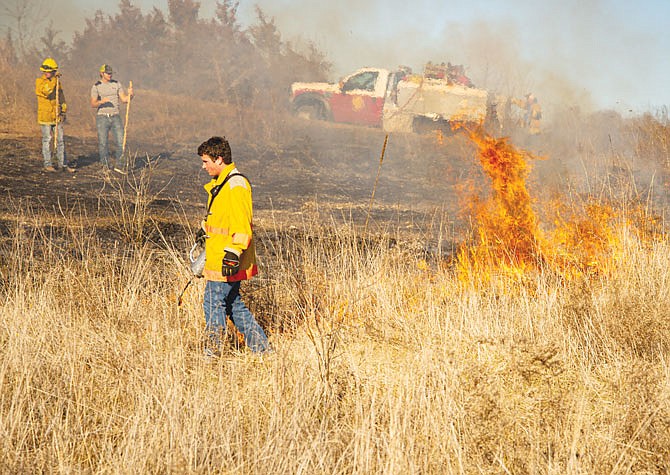When it comes to safety, "always listen to your gut," Mike Schulte told about three dozen firefighters from rural communities Saturday morning.
Schulte was with a team of staff members from the Missouri Department of Conservation who presented a class concerning fighting natural cover fires to the Central Missouri firefighters.
"Natural cover" may refer to wildfires or to prescribed fires - those that have been intentionally set to reduce hazardous fuel loads near developed areas, manage landscapes or restore natural woodlands, Schulte's colleague, Aaron Holsapple told the firefighters.
"There are many similarities between the two," Schulte said. "The methods and tactics of dealing with them are oftentimes the same."
However, wildfires are uncontrolled and generally don't have plans in place. And they can do a lot of harm to personal property.
A prescribed fire is used in a controlled manner, under safe conditions following a written plan to meet objectives, Schulte said.
"We use prescribed fire to reach a specific goal," he continued.
Conservation has cost-share programs intended to help farmers or landowners accomplish certain controlled burns.
"It's effective for wildlife. It stimulates certain kinds of plants and vegetation to attract wildlife to a property," Schulte said.
Through a couple of programs, landowners may get a burn plan prescribed for their property. More information may be found at mdc.mo.gov/conmag/2011/02/prescribed-fire-management-tool.
Any person setting a fire, whether on state land or private land, takes responsibility for the fire, Schulte said.
Conservation doesn't do it anymore, but it used to go out and help folks conduct prescribed burns on their property.
"When we did that, we always let them light the fire," he said. "So, they're the ones that take responsibility and take that liability."
Responsibility includes any damage or injury to structures, property or people. That includes damage by smoke.
It's not just the fire that people conducting prescribed burns must be aware of. They must be aware of the smoke dispersion, Schulte said.
Even if someone makes a good effort to take all the precautions they can, accidents still happen, he said.
"As long as you've done the best job possible to do that prescribed fire, it makes your actions more easily defendable if a situation arises and you get citizen complaints," Schulte said.
During a break, Cole County Fire Protection District's Alan Braun, one of the organizers of the event, said it's been several years since the district hosted a training session like the one Saturday.
The department tries to do them every few years because there is turnover in rural fire departments.
"We get a lot of new employees," Braun said. "We can't do one of these every year."
People attending the training responded, not only from the Cole County district, but also from the Russellville-Lohman, Regional West (in Apache Flats), Linn, Westphalia and other fire protection districts. Several staff members with the Jefferson City Parks, Recreation and Forestry Department also attended the event.
Fuels are a main concern when approaching a wildfire, Schulte said. Grass is a one-hour fuel, he said. It basically takes only one hour with a light breeze and a little bit of sun, and grass is ready to burn, he warned.
Leaf litter can be a one-hour fuel, but it takes longer to dry out.
Shrubs and small oak trees may hold onto their leaves all winter.
"We will do some prescribed burns in summer on some of our warm-season grass," Schulte said. "We'll do them in the summer to knock some of the shrubs and stuff back."
Six- to 8-foot-tall oak trees that have leafed-out during the summer may dry out and "torch out," he said.
As he drove to the fire department site where the training was to take place, 5206 Monticello Road, he took note of all the tornado-downed trees behind Braun Automotive.
"The first thing on my mind was 'If a fire happened in that, what are you going to do?' That would be one where I'd back out of it and just try to contain the perimeter of it," Schulte explained. "With that amount of tornado damage, that's something to keep in mind when you get a little bit out of the city. A lot of the tornado damage is cedars, with dry needles."
Nathan Morfeld, who is with the Jefferson City Forestry Division, said the city is more and more trying to get native plants to take hold.
And, having some large parks with grass and trees, the division hopes to change some practices to help stimulate replenishment of the soil. For instance, years of removing grass clippings and leaves have stripped soil at Memorial Park of nutrients, so the grass no longer grows well there.
"If we can begin implementing some more burns and get some nutrients back in the soil, maybe we can start growing grass again," Morfeld said.
The city began conducting controlled burns last year, he said.
"We've got a big park at Binder Lake, which has been let go for 30-plus years, so we've got old field," Morfeld said. "So we are going to having some larger landscape burns on specific areas."
It's something that hasn't been done, he said.
"Fire - for us, since we have the manpower and equipment - is the most inexpensive thing we can do," he explained. "Our burn window is until the end of March."
Oak Hills Golf Course Superintendent Bryan Braun attended the training Saturday. He said the course has about 7 acres administrators want to manage with fire.
"We're using (fire) for plant stimulation and weed-control," he said. "We started native area plantings about eight or 10 years ago. This will be about the third burn on those."

